Christmas market
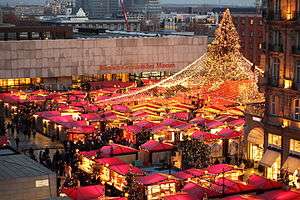

A Christmas market, also known as Christkindlmarkt, Marché de Noël, Christkindlesmarkt, Christkindlmarket, and Weihnachtsmarkt, is a street market associated with the celebration of Christmas during the four weeks of Advent. These markets originated in Germany, Austria, South Tyrol in Northern Italy and the eastern French regions of Alsace, Lorraine and Savoy.[1] The history of Christmas markets goes back to the Late Middle Ages in the German-speaking part of Europe and in many parts of the former Holy Roman Empire that includes many eastern regions of France and Switzerland. Dresden's Strietzelmarkt was first held in 1434. The Christmas markets of Bautzen (first held in 1384),[2] Frankfurt (first mentioned in 1393) and Munich (1310) Augsburg (1498) were even older. The Vienna "December market" was a kind of forerunner of the Christmas market and dates back to 1294.
In many towns in Germany and Austria, Advent is usually ushered in with the opening of the Christmas market or "Weihnachtsmarkt". In southern Germany and Austria it is sometimes called a "Christkind(e)l(s)markt" (German language, literally meaning "Christ child market"). Generally held in the town square and adjacent pedestrian zones, the market sells food, drink, and seasonal items from open-air stalls, accompanied by traditional singing and dancing. On opening nights (and in some towns more often) onlookers welcome the "Christkind" (originally boy Jesus, but more often depicted as an angel-like girl), acted out by a local child, especially at the Christkindlesmarkt in Nuremberg.
Attractions and stalls
Popular attractions at the markets include the Nativity Scene (a crèche or crib), Zwetschgenmännle (figures made of decorated dried plums), Nussknacker (carved Nutcrackers), Gebrannte Mandeln (candied, toasted almonds), traditional Christmas cookies such as Lebkuchen and Magenbrot (both forms of soft gingerbread), Bratwurst, and for many visitors one of the highlights of the market: Glühwein, hot mulled wine (with or without a shot of brandy), or Eierpunsch (an egg-based warm alcoholic drink). Both help stave off the cold winter air which sometimes dips below freezing. More regional food specialties include Christstollen (Stollen), a sort of egg bread with candied fruit in Saxony, and hot Apfelwein and Frankfurter Bethmännchen in Hesse. Many other handmade items, toys, books, Christmas tree decorations and ornaments (and in recent years less useful gadgets) can be found at a Christmas Market.
Famous Christmas markets are held in the cities of Augsburg, Dresden, Erfurt, Frankfurt, Nuremberg and Stuttgart, making them popular tourist attractions during Christmas holiday season.[3][4] The Nuremberg and Dresden markets draw about two million people each year; the Stuttgart and Frankfurt markets attract more than three million visitors. The two most visited Christmas markets in Germany are to be found in Dortmund with more than three and a half million visitors of 300 stalls around a gigantic Christmas tree creation that stands 45 metres tall, and in Cologne with 4 million people.[5] Additionally, Berlin claims over 70 markets, which open in late November and close just after Christmas.[6]
Christmas markets are traditional in Alsace and most of the towns have their local Christmas market. Strasbourg, in Alsace, France, has been holding a Christmas market, "Christkindelsmärik," around its cathedral since 1570, when it was part of the Holy Roman Empire of German Nation.[7]
In 1982 Lincoln, England established an annual Christmas market in early December, and this remains one of the most extensive such market by area in the United Kingdom, with a claimed total of over 300 stalls attracting more than 100,000 visitors over its four days. Starting in 1997 Frankfurt Christmas Markets were established with support from Frankfurt in the British Cities of Birmingham, Edinburgh, Leeds and Manchester.[8] Other large Christmas markets have been held in England in Bath (since 2000) or Liverpool (since 2006). The Christmas markets are such a success that they are becoming a major pull factor to increase trade and visitor numbers to towns and cities. Manchester's Christmas Markets have been particularly successful with 300 stalls over 8 city locations with each location being themed to create a different atmosphere such as French, World and German, with European themed stalls on the Albert Square, Manchester proving to be the most popular.[9][10]
German immigrants also brought the Christmas market celebrations to the United States.[11][12][13][14][15]
Since 2007, a traditional Christmas market is held for the first time in Sibiu, Romania. The first of its kind in Romania, it is inspired by Viennese Christmas markets, being a project developed by the Social Attaché of the Austrian Embassy in Romania, dr.h.c. Barbara Schöfnagel It was held in the "Lesser Square" (Piața Mică) with 38 small stalls, a small stage and an area dedicated to children, having several mechanical attractions installed there. Since 2008 the market is held in the "Grand Square" and grew to a number of about 70 stalls, a bigger stage was set up, where Christmas carols concerts are held. An ice skating rink and a children's workshop are also attractions which have been added in the following years.[16] It was the first Christmas Market in Romania,[17] but soon other Christmas markets emerged across the country. In 2013, the Sibiu Christmas markets was included in the "15 Of the Most Beautiful Christmas Markets in Europe"[18]
The oldest Christmas market in Europe, the Christkindelsmarik was first held in Strasbourg in 1570. With its 300 stalls, spread out over 12 locations in the city center, the authenticity, warmth and generosity of Strasbourg Capital of Christmas form an Alsatian tradition which has been successfully maintained ever since. [19]
Gallery
-
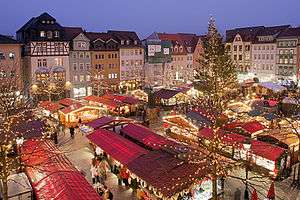
Christmas market in Jena
-

In Colmar, 2010
-
.jpg)
Christmas market, Strasbourg, France
-

German Christmas market in Millennium Square, Leeds, UK
-

Traditional gingerbread hearts at a German Christmas market
-

Christmas market stalls
-
Ferris Wheel at the Hyde Park Christmas Market
-
Christmas market in Erfurt
-
Christmas market in Stuttgart, Baden-Württemberg
-

Salzburg, Austria
-

Christkindlimärt in Rapperswil, Switzerland
-

2009 Julmarknad ("Christmas market") in Gamla stan, Stockholm
-

Vienna, Austria
-
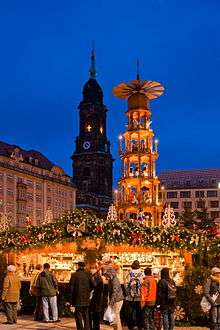
The Striezelmarkt in Dresden
-

Sternschnuppenmarkt in Wiesbaden, Germany
-
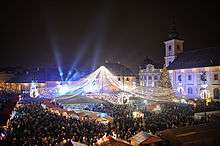
The Sibiu Christmas Market in Sibiu, Romania
-
.jpg)
Nikolausdorf- Christmas Market at Rudolfplatz, Cologne, Germany
-

The Christmas Market in Zagreb, Croatia
-

Christmas market at Gendarmenmarkt, Berlin
| Wikimedia Commons has media related to Christmas markets. |
| Wikimedia Commons has media related to Christmas markets in Germany. |

See also
| Wikivoyage has a travel guide for Christmas markets. |
References
- ↑ http://noel.org
- ↑ Bautzen Christmas Market
- ↑ Christmas City Nuremberg Stadt Nürnberg, retrieved 8 July 2007
- ↑ Stuttgart Christmas Market Stuttgart Marketing, retrieved 8 July 2007
- ↑ "Weihnachtsmärkte: Köln ist Publikumsmagnet : Topnews". Topnews.de. Retrieved 2013-05-06.
- ↑ Innes said... (2011-12-26). "Top Berlin Christmas Markets". On London Time. Retrieved 2013-05-06.
- ↑ Noël à Strasbourg Retrieved 8 July 2007
- ↑ "Frankfurt Christmas Markets Great Britain Scotland England". Frankfurt-tourismus.de. Retrieved 2013-05-06.
- ↑ Denise Evans (2012-11-18). "Manchester Christmas Markets 2012: A guide to the city's festive stalls - Manchester Evening News". Menmedia.co.uk. Retrieved 2013-05-06.
- ↑ "Mapped: Manchester set for 'biggest and best ever' Christmas markets - Manchester Evening News". Menmedia.co.uk. 2012-11-02. Retrieved 2013-05-06.
- ↑ CHRISTKINDLMARKT BETHLEHEM ArtsQuest (2006), retrieved 8 July 2007
- ↑ . Christkindlmarket Chicago German American Chamber of Commerce of the Midwest, 17 November 2006, retrieved 8 July 2007
- ↑ Denver Christkindl Market German American Chamber of Commerce Colorado Chapter. (2006), retrieved 8 July 2007
- ↑ Mifflinburg Christkindl Market
- ↑ Christkindlmarkt 2007 German-American Society of Tulsa, 1 May 2007, retrieved 8 July 2007
- ↑ Târgul de Crăciun din Sibiu
- ↑ Press Release Primaria Sibiu
- ↑ http://www.tourismontheedge.com/best-of/christmas-traveling-15-of-the-most-beautiful-christmas-markets-in-europe.html
- ↑ "Best Christmas Markets in Europe - ilovetraveling.org". I Love Traveling. Retrieved 2016-11-08.
Further reading
- Bakst, Alex: "A Visit to Germany's Christmas Markets", Spiegel Online 7 December 2006
- Zug, J.D. (1991): German-American Life: Recipes and Traditions, Iowa City: Penfield Press
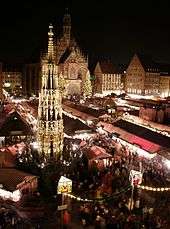
.jpg)